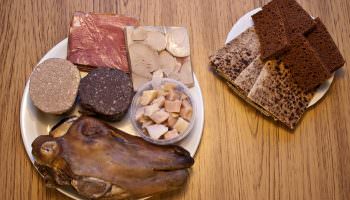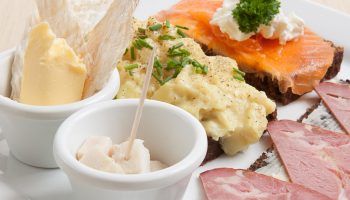Traditional Icelandic food was born out of necessity dictated by weather and circumstances. The preservation of food was a matter of survival over the winter months when meat and fish were scarce. Housewives used various methods to preserve as much food as possible. Meat was smoked, salted, pickled or put in whey for 3 – 4 months, giving it a very specific sour taste. Fish was dried, hanged, salted, smoked or allowed to cure for some time. Almost everything from the animal was used.
A few examples of the “delicacies” made from Icelandic sheep are blood and liver pudding, singed sheep heads, smoked lamb and ram testicles! If you would like to taste some of these special treats, try Café Loki near the Hallgrímskirkja Cathedral. It is also possible to buy some delicacies in a nearby grocery store. The infamous fermented shark (hákarl) is an acquired taste and goes down well with a shot of Icelandic schnapps, Brennivín
Try rye pancakes (flatkaka), sliced smoked lamb (hangikjöt) and some butter to make a tasty snack. Smoked salmon (lax) on rye bread (rúgbrauð) is also popular. Other bread toppings include marinated herring, rolled sausage and lamb pâtés.
When going on a camping trip or just driving in the countryside, take some dried fish (harðfiskur) with you from the nearest service station. It is the perfect lightweight snack, which most Icelanders pack when going on a picnic or hike. Don‘t let the smell put you off. Most of the above foods can be found in grocery stores and at the airport duty free stores.


